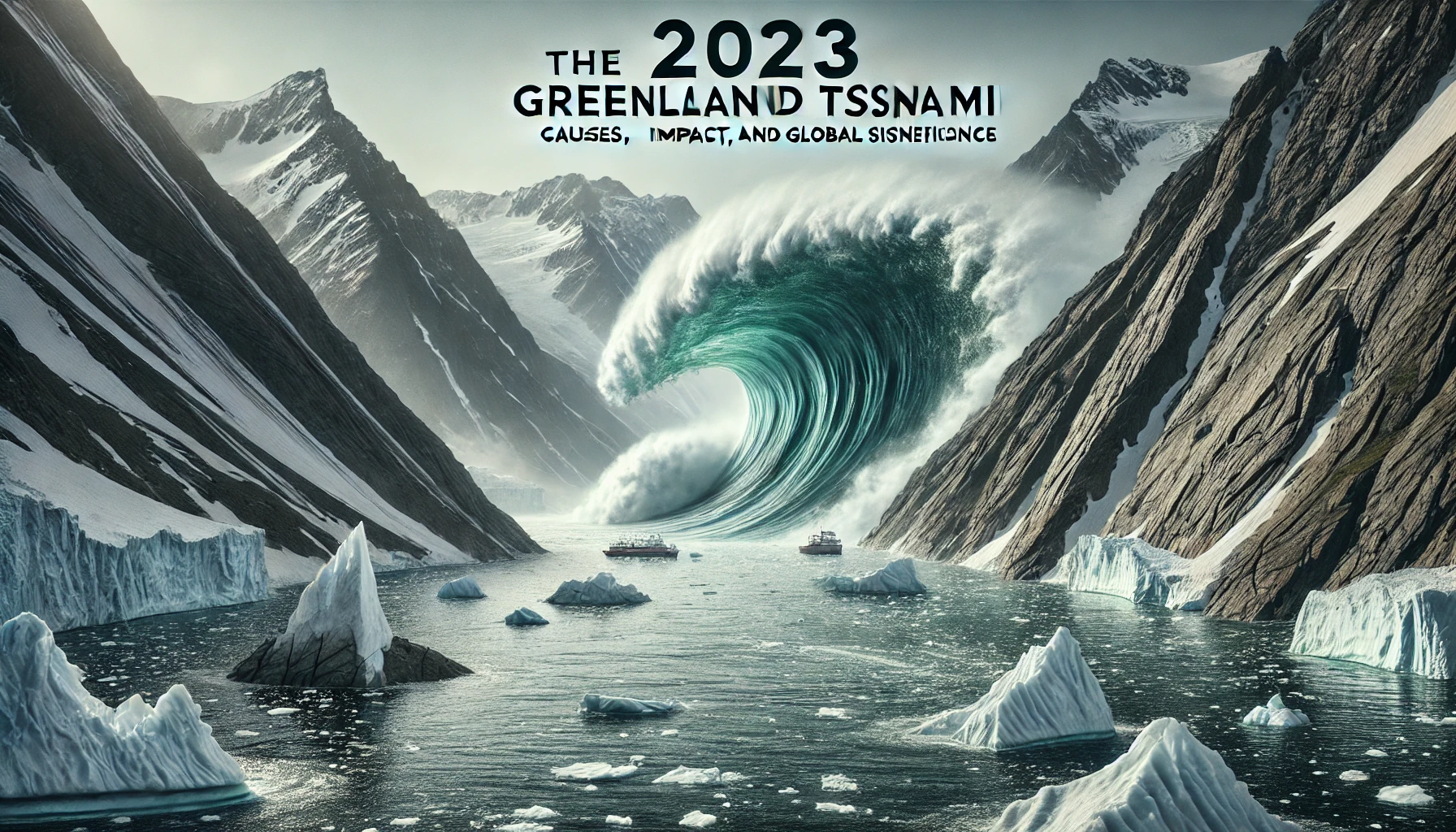The 2023 Greenland Tsunami: What Happened and Its Global Impact
The 2023 Greenland Tsunami: In September 2023, the world witnessed a rare and catastrophic natural event: a massive Greenland tsunami that sent shockwaves across the globe, both literally and figuratively. Triggered by a landslide, the Greenland tsunami 2023 led to unprecedented seismic activity, raising questions about climate change, the stability of glaciers, and the future of coastal communities worldwide. In this blog, we will explore the causes, the impact, and the scientific significance of this event, delving into wave height, duration, and the specific role of Greenland’s Dickson Fjord.
What Triggered the 2023 Greenland Tsunami?
The Greenland tsunami 2023 was caused by a massive landslide in Dickson Fjord, a remote area in eastern Greenland. This isn’t the first time a landslide-induced tsunami has occurred in Greenland—similar events have happened in the past due to the region’s unstable terrain. Greenland’s towering cliffs and glaciers, combined with increasing temperatures and melting ice, make the area prone to landslides, which can lead to devastating tsunamis.
The Landslide and Initial Impact
The massive rockslide that triggered the tsunami sent a shockwave of water through the fjord, creating what scientists call a megatsunami. The wave was so powerful that it oscillated in the fjord for days, creating long-lasting seismic waves that were detected as far as 5,000 kilometers away. The seismic signals caused by the landslide were followed by a tsunami wave height that dwarfed most normal tsunami events.
Greenland Landslide Tsunami: A Growing Concern
With the Greenland landslide tsunami phenomenon becoming more frequent, scientists are increasingly concerned about the role of climate change in triggering these events. Melting ice and thawing permafrost are destabilizing the region’s rocky cliffs, making landslides—and the resulting tsunamis—more likely. Understanding the mechanisms behind these events is critical to predicting and mitigating future disasters.
The Scale of the Wave: Unprecedented Height and Duration
One of the most remarkable aspects of the 2023 Greenland tsunami was its sheer scale. The wave height reached over 100 meters in some areas, putting it in the category of a megatsunami. This is much higher than typical tsunami waves, which usually range between 10 to 30 meters.
Greenland Tsunami Wave Height: Reaching Unimaginable Levels
In the aftermath of the event, researchers measured the Greenland tsunami wave height and found that it was much larger than anticipated. A megatsunami of this scale is incredibly rare, but it highlights the severity of the landslide that caused it. Waves of this size can destroy everything in their path, and in this case, they left a visible impact on the remote landscape of eastern Greenland.
Tsunami in Greenland Fjord: Understanding the Wave Dynamics
The Dickson Fjord tsunami occurred in a confined body of water, which further amplified the wave’s strength and duration. The geography of fjords—narrow, steep-sided inlets—makes them particularly susceptible to long-lasting wave action. In this case, the wave continued oscillating in the fjord for nearly a week, creating what is known as a “seiche”—a standing wave that sloshes back and forth between the fjord’s walls.
Seismic Waves: Detecting the Tsunami Across the Globe
One of the most fascinating aspects of the 2023 Greenland tsunami was how far its effects were felt. The tsunami triggered Greenland tsunami seismic waves, which were picked up by monitoring stations across the globe. Scientists recorded these seismic waves thousands of kilometers from Greenland, a testament to the sheer power of the event.
Greenland Tsunami Seismic Wave: Global Detection and Study
Seismologists were able to detect two main types of seismic signals from the event. The first signal was a high-energy spike caused by the landslide itself. The second signal, which lasted much longer, was caused by the seismic wave generated by the tsunami. This wave reverberated around the globe for days, providing valuable data for researchers studying the dynamics of tsunami events.
Long-Term Impact: How the 2023 Greenland Tsunami Affects Future Research
The Greenland tsunami 2023 has provided scientists with a wealth of data, particularly regarding the interaction between climate change and natural disasters. With global temperatures on the rise, events like this could become more frequent. Greenland’s glaciers are melting at an accelerated rate, and this loss of ice is causing the region’s rocky cliffs to become more unstable.
Impact on Coastal Communities
Although the 2023 Greenland tsunami occurred in a relatively unpopulated area, it serves as a warning for coastal communities around the world. As climate change continues to destabilize natural features like cliffs and glaciers, similar events could happen in more populated regions, potentially causing widespread destruction. The scientific community is urging governments to invest in early warning systems and monitoring technologies to predict and mitigate future disasters.
What’s Next? Studying Future Tsunami Risks
The Greenland megatsunami and similar events are raising new questions for the scientific community. How do we better predict landslides and their resulting tsunamis? What role does global warming play in increasing the frequency of these events? The 2023 Greenland tsunami has sparked renewed interest in these questions, and researchers are now focused on studying the region more closely.
2023 Greenland Tsunami Impact on Global Research
The 2023 Greenland tsunami impact extends far beyond the shores of Greenland. This event has spurred global interest in monitoring areas prone to landslides and tsunamis, particularly in regions where the loss of permafrost is creating instability. As more data is collected, scientists hope to develop better models for predicting future events.
The Global Significance of the Greenland Tsunami 2023
The 2023 Greenland tsunami was a rare and catastrophic event that captured the world’s attention. Its sheer wave height, seismic activity, and long-lasting wave duration have provided scientists with invaluable data, helping to shed light on the connection between climate change and natural disasters. As we look to the future, understanding the causes and impacts of events like the Greenland landslide tsunami will be essential in preparing for and mitigating similar disasters.
For more in-depth information on how natural disasters like the 2023 Greenland tsunami shape our understanding of the environment, visit Regent Studies. And for additional resources on tsunamis and seismic activity, check out this detailed report from the Seismological Society of America here.
The Greenland tsunami is a stark reminder of the growing risks posed by climate change and natural instability. By studying this event, scientists can better prepare for the challenges that lie ahead.




